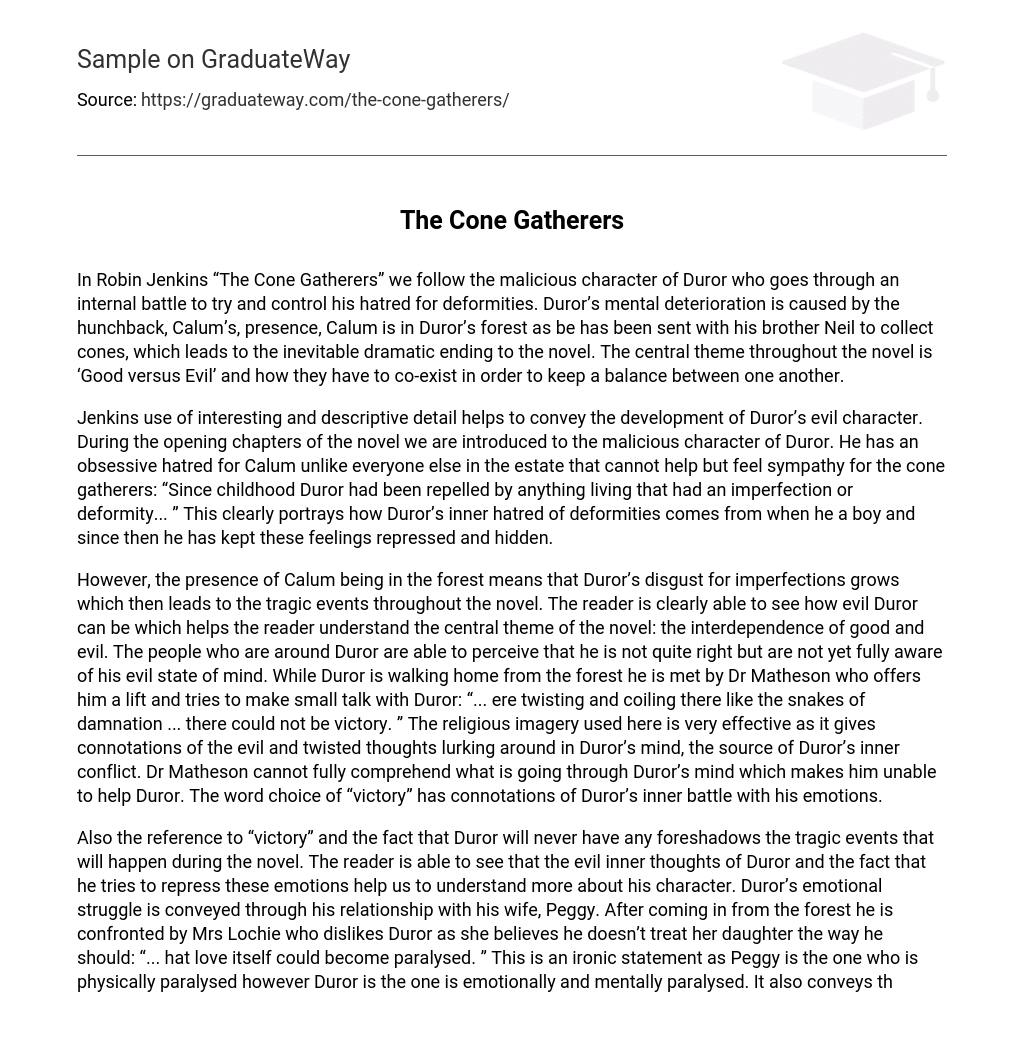Robin Jenkins’ “The Cone Gatherers” tells the story of Duror, a malicious character who struggles to suppress his intense dislike towards deformities. Duror’s mental decline is triggered by the presence of Calum, a hunchback who is sent along with his brother Neil to gather cones in Duror’s forest. This ultimately leads to a gripping conclusion of the novel. The main theme explored throughout the book is the conflict between good and evil and the need for both to coexist harmoniously to maintain balance.
Jenkins effectively communicates Duror’s progression into an evil character through the use of intriguing and vivid details. In the early chapters of the book, Duror’s malicious nature is introduced. He harbors an obsessive animosity towards Calum, unlike the rest of the estate’s inhabitants who sympathize with the cone gatherers. The quote “Since childhood Duror had been repelled by anything living that had an imperfection or deformity…” illustrates how Duror’s deep-rooted loathing for deformities stems from his childhood. Over time, he has suppressed and kept these emotions hidden within him.
The presence of Calum in the forest causes Duror to become even more disgusted by imperfections, leading to tragic events in the novel. Through Duror’s actions, the reader sees his true evil nature, helping them understand the central theme of the interdependence of good and evil. Those around Duror notice that something is off about him but are not yet aware of his evil mindset. While walking home from the forest, Duror encounters Dr Matheson, who offers him a ride and attempts to make conversation: “…twisting and coiling there like the snakes of damnation…there could be no victory.”
The religious imagery utilized in this text is highly impactful as it implies the presence of malevolent and distorted thoughts within Duror’s mind, which serves as the origin of Duror’s internal struggle. Dr Matheson lacks complete understanding of Duror’s thoughts, rendering him incapable of providing assistance to Duror. The use of the term “victory” carries connotations of Duror’s internal conflict with his emotions.
Additionally, the mention of “victory” and Duror’s inability to ever achieve it foreshadow the tragic events that will transpire throughout the novel. Through his inner thoughts and attempts to suppress his emotions, we gain a greater understanding of Duror’s character. The emotional turmoil Duror experiences is evident in his relationship with his wife, Peggy. Upon returning from the forest, he is confronted by Mrs. Lochie, who disapproves of Duror’s treatment of her daughter by stating that “love itself could become paralyzed.” Ironically, it is Peggy who is physically paralyzed while Duror is emotionally and mentally paralyzed.
The text highlights how Duror’s intense hatred extends even to his immediate family, particularly towards his obese wife. This establishes Duror as a malevolent and vengeful character, evident in his aversion towards deformities. Furthermore, Duror’s inner turmoil becomes evident during the pivotal moment of the deer drive.
During the deer drive, a wounded deer is found. Calum, in a sympathetic manner, throws himself onto the wounded deer. However, Duror, emerging from the forest, intends to kill the deer and exhibits a twisted sense of joy. Duror’s actions of slitting the deer’s throat and remaining with it demonstrate his complete lack of control due to his deeply concealed hatred. Additionally, the reader becomes aware of Duror’s intense hatred for Peggy as he visualizes her as the deer he is attacking.
The depiction of Duror laughing in this image emphasizes the presence of evil within him, thus underscoring the central theme of good versus evil. Additionally, the image also demonstrates the coexistence of good and evil, as Calum’s compassion towards the deer showcases the effective representation of this theme. Furthermore, Duror expresses his animosity towards Calum through the lies he spreads about the cone gatherer.
Duror lies to Lady Runcie Campbell about a doll that he claims Calum stole from the beach hut, using “the most loathsome accusations against the little cone gatherer.” This demonstrates Duror’s loss of control and his attempt to conceal his evil emotions by lying about Calum. By suggesting terrible actions by Calum, Duror tries to convince Lady Runcie Campbell that Calum is unfit for the woods. This causes Lady Runcie Campbell to realize that Duror is mentally unstable. The use of the word “little” adds connotations of Calum’s innocence and goodness, highlighting the theme of good versus evil. Ultimately, Duror’s malicious character leads to the tragic climax of the novel.
Lady Runcie Campbell arrives at Scour Point to ask for the assistance of the cone gatherers, only to discover that she is too late. She hears a gunshot and realizes that Duror has killed Calum. As she watches Duror walking away from the scene, she is struck by the overwhelming sense of despair in his every step. This haunting image of Duror stays with her, causing restless nights for months. Now, Lady Runcie Campbell, who has personally witnessed the horrors and emptiness within Duror, is now a firsthand observer of the culmination of his instability.
Duror kills Calum, which leaves him feeling empty. This emptiness encompasses both emotions and humanity, transforming Duror into a hollow person. Without his hatred for Calum, Duror has no purpose in life. Unable to go back or move forward, Duror ultimately takes his own life. This tragic conclusion of the book effectively highlights the central theme of the novel: the coexistence of good and evil, which balance each other out. This theme is conveyed through Calum’s sacrifice, which ultimately leads to Duror’s death and profoundly impacts the lives of those in the wood.





